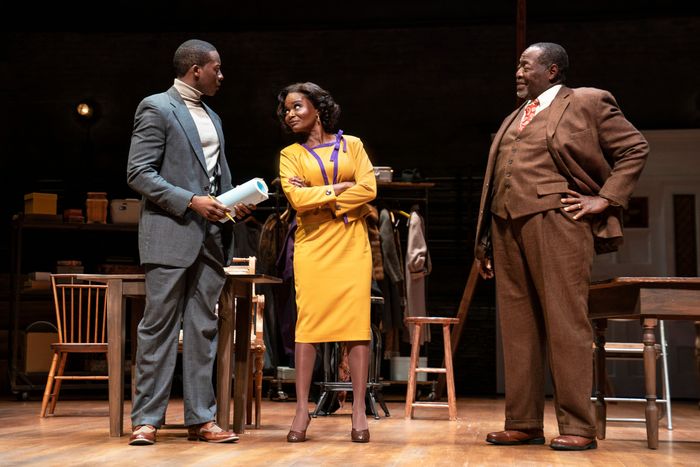
Just before the Roundabout revival of Alice Childress’s masterpiece Trouble in Mind begins, the preshow announcement offers us some context. After welcoming us back to live performance, the voice welcomes Childress herself to Broadway, about six decades late. (After the play’s 1955 premiere Off Broadway, white producers tried to force her to soften Trouble’s ending, and she said no. Their Broadway production was scrapped.) The announcement puts us firmly in the play’s corner — my audience gave a little cheer — but it also focuses attention on the way those final beats should land like blows. The text still contains astonishing power; it could have been written yesterday. But Charles Randolph-Wright’s production wavers in several crucial moments, and the show slows rather than sharpens as it comes to a close.
Trouble in Mind is a sore-hearted farce, a realistic portrait of acting while Black, and (potentially) a crisp backstage comedy. Before she wrote it, Childress had acted for many years with the American Negro Theatre, and she distilled a decade of precise observations into her script, from the mid-century rise of actorly Method jargon to the exaggerated hierarchies of Equity snack breaks. Her ear was particularly attuned to the sound of white, liberal theater folks pleading good intentions as they tread a middle-aged Black actress underfoot. For Trouble, Childress imagined an empty theater itself as her set, then populated it with theater’s familiar types. Her plot is simple: During a sequence of rehearsals for a (clearly awful) Broadway play, the young actors try to impress each other; the older actors tend to their own fragile egos; the director fakes wisdom he doesn’t have; the stage manager seethes. To quote another show that’s a couple of blocks away at the moment: same as it ever was.
The production doesn’t play the song made famous by Nina Simone until after the curtain call, but you might have the lyrics echoing somewhere in your thoughts.
Trouble in mind, I’m blue
But I won’t be blue always
’Cause the sun’s gonna shine
In my back door some day
When LaChanze’s Wiletta Mayer first comes running through the audience and climbs up to the stage, she certainly seems sure of that sunshine. She radiates optimism for this first day of rehearsals, brilliant in a marigold-yellow suit that rises through her purple overcoat like dawn. (Emilio Sosa did the costume design.) On the page, Wiletta has doubts, but LaChanze takes the character’s ambition —“I’ve always wanted to do somethin’ real grand,” she says — and turns it up like a klieg light. After all, Wiletta is an old hand: she knows the ropes, knows everybody. Even the doddering Irish doorman Henry (Simon Jones) recognizes her from a revue long past, and for a brief moment before the others enter, he treats her like a celebrity. In response, LaChanze’s glow expands, a star going nova.
But then the others enter. The Black actors come early; the white ones trickle in. Expansive with experience, Wiletta tries to take the rising talent John (Brandon Micheal Hall) under her wing, telling him how to handle the white people (“Laugh at everything they say, makes ’em feel superior”), though her cynicism shocks him. Wiletta, tart Millie (Jessica Frances Dukes), and accommodating Sheldon (Chuck Cooper) go way back, but their good-natured bickering turns sour, especially when Sheldon’s get-along, soft-soap approach goes too far. Wiletta has even worked with their white director Al Manners (Michael Zegen) before, yet all her savvy somehow still leaves her on the back foot. The younger performers, the Sidney Poitier-esque John and white ingenue Judy (Danielle Campbell), share a language of “justifications” and “motivations” with Manners, and the director’s jolly bullying turns cruel as first he demands that the bewildered Wiletta think his way, then that she not think at all. He’s pretty sure he’s a genius, so why can’t she get on his level? As the others rush to do his bidding, Manners deliberately provokes her, isolates her, ignores her. But it’s the arts, darling — so he also keeps saying he loves her.
One of the pleasures of Trouble in Mind is the way Childress pokes accelerating fun at theater’s many pretensions, yet this is just where Randolph-Wright’s staging drags at the play’s machine. The show is a wheel within a wheel: Wiletta’s tragic frustration grows slowly as the plot progresses, but she’s surrounded by a whizzing backstage comedy, which mocks the theater’s insistence on feeling “truth” while playing stereotypes and lies. (The anti-lynching play they’re working on is manifestly racist, but Wiletta is the only one who notices, or at least the only one willing to call it out.) Childress’s humor relies on a clear distinction between the Method trained actors and the older generation, but weirdly Randolph-Wright has Manners work in a stilted, melodramatic vein, which would certainly have struck all of the characters as outdated. It also weakens much of the satire. Randolph-Wright himself tends towards a presentational style, keeping the actors arranged as though they’re posing for a magazine portrait. For much of Act One, they sit evenly spaced in a line across the stage; they often deliver their lines out to the house rather than to each other. One powerful moment — when LaChanze lets fly with her trumpet-of-Jericho mezzo-soprano belt — is notable because she delivers it in profile, one of the few moments when anyone turns away from the audience.
Part of the problem is the theater itself. The Roundabout’s American Airlines is a barn, a huge, wide, intimacy-killing room. There’s an awful irony in the idea that this specific Broadway house is inhospitable to a production that so manifestly belongs on Broadway. There are, though, ways the show could fight back against the venue, primarily by simply giving the ensemble more to do. Childress offers a story that implies comic business and bustle — and yet there’s little of that here. Of course, without a Noises Off–style whirlwind to distract us, we can focus on the quieter places of excellence, like Cooper’s gorgeous portrait of Sheldon. On the page, Sheldon is peripheral, but Cooper makes him into the soul of the production, a great deep well of knowledge, compromise, and sorrow. There are other things to look at — Manners paces back and forth at the lip of the stage, Millie and Wiletta both wear vivid peacock colors — but my eyes turned again and again to him. He blustered and laughed, shook his head at everyone else’s nonsense. But every time he got still, it was like a storm was gathering. You could see the light darken around his head; you could feel the air fill with trouble.
Trouble in Mind is at the American Airlines Theatre through January 9.





